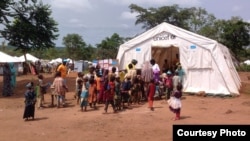Thousands of children from the Central African Republic continue arriving in eastern Cameroon as refugees – more than 18 months since a coup d’état sparked a cycle of killings in their country. They have sought safety in camps next door in Cameroon, but they are not getting the education they need. With little donor money coming in, relief workers can only do the barest minimum such as teacher children songs and handwork.
This year alone, more than 106,000 Central Africans crossed the border. Relief workers expect the number to reach 180,000 by the end of the year. The vast majority of them, about 60 percent, are children who have now been put out of school.
Challenges on Cameroon’s eastern border
Refugee camps have mushroomed along Cameroon’s eastern border and challenge officials who must try to educate young residents as other life-threatening emergencies rage on: malnutrition, sanitation and personal security from violence.
Every morning hundreds of children squat on mats under large white tents in the Gado Badzere camp to sing and recite rhymes. It’s their only chance to forget the mayhem back home and the atrocities they have encountered during their flight.
The learning and recreation areas are called “child-friendly zones” and they were carved out by UNICEF and run by a local organization. Many of those who care for the children are unpaid volunteers recruited from the ranks of the refugees themselves.
When a tailor becomes a teacher
Zaibabou Kaleb was a tailor before the killings began and she fled. She is one of a dozen refugees who have been drafted to supervise children and teach basic skills at the refugee camp, which is home to over 13,000 refugees.
Kaleb says most of the children would like to be in school but don’t have the opportunity. She says at the “child friendly-zone” boys learn how to make wooden toys and girls how to sew. They also listen to educational talks on a variety of subjects.
UNICEF, which has been looking out for the welfare of young refugees, says education is an important priority: only 3 percent of all children of school-going age in refugee camps have ever been to school.
Felicite Tchibindat is UNICEF’s resident representative in the capital, Yaounde. She says it would be hard to put them in local schools in Cameroon.
Three percent have been in a school before
“That is why we took this option of a temporary space to start preparing them and we do have accelerated curricula to help them go to school,” says Tchibinbat. “And then, those who have been to school, we have to evaluate their level and see in which class they should be. Before that we need space for children to start rebuilding, getting their life back to normal.
The program seems to be paying off. Children are beginning to master different skills. Some have developed self-confidence and are willing to walk forward and perform recitations.
The number of children attending educational and recreational activities has been growing, because parents themselves see the importance of education. But Tchibindat says critical obstacles remain.
“The biggest phase will be how to increase the capacity of the different schools in the community so that they are able to accommodate refugees. We know already that this region is a priority-education region, meaning that there are fewer classrooms, fewer teachers, and all that.”
Lack of resources could hamper the plans of organizations like UNICEF. With so many crises in the world, the plight of Central African refugees appears to be getting very little attention from donors. UNICEF, for example, says it needs around $25-million for all its interventions this year. But half-way through the year, only 15 percent has come in.





